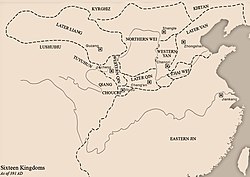Western Qin
Appearance
This article needs additional citations for verification. (December 2015) |
Western Qin (西秦) 苑川 (387–388) 河南 (388–389, 394, 411–414) 金城 (389–394) 梁 (394–395) 秦 (395–400, 409–411, 414–431) | |||||||||||||
|---|---|---|---|---|---|---|---|---|---|---|---|---|---|
| |||||||||||||
 Western Qin and its neighbors in 391 AD | |||||||||||||
| Status | Vassal of Former Qin, Later Qin, Jin Dynasty (266–420), Northern Wei | ||||||||||||
| Capital | Yongshicheng (385–386) Wanchuan (386–388, 400, 410–412) Jincheng (388–395) Xicheng (395–400) Dujianshan (409–410) Tanjiao (412) Fuhan (412–429) Dinglian (429–430) Nan'an (430–431) | ||||||||||||
| Government | Monarchy | ||||||||||||
| King | |||||||||||||
• 385–388 | Qifu Guoren | ||||||||||||
• 388–400, 409–412 | Qifu Qiangui | ||||||||||||
• 412–428 | Qifu Chipan | ||||||||||||
• 428–431 | Qifu Mumo | ||||||||||||
| |||||||||||||
| Today part of | China | ||||||||||||
The Western Qin (Chinese: 西秦; pinyin: Xī Qín; 385–400, 409–431) was a dynastic state of China ruled by the Xianbei ethnicity during the era of Sixteen Kingdoms.[1] All rulers of the Western Qin declared themselves "wang", translatable as either "king" or "prince." They ruled an area corresponding to modern-day southwestern Gansu in Northwest China.
Rulers of the Western Qin
| Temple name | Posthumous name | Personal name | Durations of reign | Era names |
|---|---|---|---|---|
| Liezu | Xuanlie | Qifu Guoren | 385–388 | Jianyi (建義) 385–388 |
| Gaozu | Wuyuan | Qifu Qiangui | 388–400, 409–412 | Taichu (太初) 388–400 Gengshi (更始) 409–412 |
| Taizu | Wenzhao | Qifu Chipan | 412–428 | Yongkang (永康) 412–419 Jianhong (建弘) 420–428 |
| – | – | Qifu Mumo | 428–431 | Yonghong (永弘) 428–431 |
The family tree of Western Qin rulers
| Western Qin | |||||||||||||||||||||||||||||||||||||||||||||||||||||||||||||||||||||||||||||||||||||||||||||||||||||||||||||||||||||||||||||||||||||||||||||||||||||||||||||||||||||||||||||||||||||||||||||||||||||||||||||||||||||||
|---|---|---|---|---|---|---|---|---|---|---|---|---|---|---|---|---|---|---|---|---|---|---|---|---|---|---|---|---|---|---|---|---|---|---|---|---|---|---|---|---|---|---|---|---|---|---|---|---|---|---|---|---|---|---|---|---|---|---|---|---|---|---|---|---|---|---|---|---|---|---|---|---|---|---|---|---|---|---|---|---|---|---|---|---|---|---|---|---|---|---|---|---|---|---|---|---|---|---|---|---|---|---|---|---|---|---|---|---|---|---|---|---|---|---|---|---|---|---|---|---|---|---|---|---|---|---|---|---|---|---|---|---|---|---|---|---|---|---|---|---|---|---|---|---|---|---|---|---|---|---|---|---|---|---|---|---|---|---|---|---|---|---|---|---|---|---|---|---|---|---|---|---|---|---|---|---|---|---|---|---|---|---|---|---|---|---|---|---|---|---|---|---|---|---|---|---|---|---|---|---|---|---|---|---|---|---|---|---|---|---|---|---|---|---|---|
| |||||||||||||||||||||||||||||||||||||||||||||||||||||||||||||||||||||||||||||||||||||||||||||||||||||||||||||||||||||||||||||||||||||||||||||||||||||||||||||||||||||||||||||||||||||||||||||||||||||||||||||||||||||||
See also
References
- ^ Grousset, Rene (1970). The Empire of the Steppes. Rutgers University Press. pp. 59–60. ISBN 0-8135-1304-9.
Categories:
- Western Qin
- 385 establishments
- 400 disestablishments
- States and territories established in the 400s
- 409 establishments
- 431 disestablishments
- Dynasties in Chinese history
- Former countries in Chinese history
- 4th-century establishments in China
- 5th-century establishments in China
- 5th-century disestablishments in China
